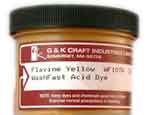How should I dye my dry-clean-only silk taffeta dress?
Name: Caroline
Country or region: United States
Message: Hello, I am looking for some advice on dyeing a silk taffeta dress. When I have dyed things in the past, I have ended up with streaky or patchy color. Using my washing machine has greatly improved this. Here are my questions:
1. Which dyes would you recommend? Are there other items I should buy that could help to even the dying?
2. Since the dress is dry clean only, I am guessing washing machine dyeing isn't a good idea. Is there any way to dye silk taffeta? There must be, since it was dyed at some point... right?
3. What are the risks of washing silk taffeta?
4. Since this is a material that has a two tone color (pink overall but it has flashes of gray from another light) will it appear as a uniform color after dying?
Let me answer your questions in a different order than the order in which you asked them.
First, you can't dye anything without washing it. There is no way to dye a garment without having to wash it, both before and after dyeing. You must wash it before dyeing, to remove surface finishes and any invisible stains that will result in uneven dyeing, and you must wash it after dyeing in order to remove the unattached excess dye, which will rub off on other clothing or furniture if you do not remove it.
However, many garments marked "dry clean only" will survive washing just fine. If you have no use for the dress in its current color, then you may as well try washing it, on the most delicate setting your machine can manage. If it survives washing, then you can go ahead and dye it. Don't try this if you don't hate the original color of the dress, since it is quite possible that the dress will be ruined by washing. Also, do not try this with any garment that has a lining.
The threads in your iridescent silk dress were dyed before they were woven together. The risks of washing it now depend on why it was marked "dry clean only". It may be that it was dyed with non-wash-resistant dyes which will bleed when they get wet. It may be that the silk was finished, after dyeing, with some treatment such as tin salts or their modern equivalent, which will wash out in water, leaving the fabric with much less body and none of the original stiffness or luster. It could be that the dress was sewn together so poorly that the stitching will become unraveled when it is washed, or that the fabric is fragile and may wear out very quickly when washed. If the dress is lined, then the lining is almost certainly made of a synthetic fiber such as acetate, which will not shrink to the same degree as the outer fabric; if so, the differential shrinkage will ruin the shape of the dress. Silk in itself can be washed, but the way some silk dresses are constructed means that they can no longer survive washing. Or, it could be that the dress can be washed safely, but the manufacturer found it simpler to mark all of their dresses as safe for dry cleaning only.
Dyeing an iridescent silk will change both of the colors that it's woven from. The yarns of the warp, which go in one direction, are dyed a different color than the yarns of the weft, which run in the perpendicular direction. If you start with a fabric that is woven from pink and gray silk, then overdye it another color, both the pink and the gray will change. The two colors will not be quite the same as each other after dyeing, but they will be much more similar, so the iridescent effect will be mostly destroyed.
If you decide to go ahead with dyeing this dress, after successfully washing it, I recommend that you again use the washing machine for your dyeing, using a delicate setting. See "How can I dye clothing or fabric in the washing machine?". The best type of dye to use would be acid dye, in the hottest water possible, using a mild acid such as vinegar. You may need to temporarily increase the temperature setting on your water heater. Jacquard Products provides a set of instructions online (linked to on that page) for using their acid dyes in the washing machine. The other kind of dye you can use is fiber reactive dye; you can apply Procion MX fiber reactive dye in lukewarm water, but the soda ash required to fix the dye will make your silk softer and a little bit less shiny, so I think that you would prefer acid dye. Weigh the dress first, after washing it and allowing it to dry, so that you will be able to calculate how much dye will be required.
Posted: Friday - March 11, 2011 at 08:12 AM
Follow this blog on twitter here.
Quick Links
- All About Dyes & Dyeing Top -
- Top of this blog -
- FAQ -
- The Dye Forum -
- How to Tie Dye - How to Batik -
- Books - Toys - Plants -
- Top of this blog -
- FAQ -
- The Dye Forum -
- How to Tie Dye - How to Batik -
- Books - Toys - Plants -
More in this category:
- -
Statistics
Total entries in this blog:
Total entries in this category:
Published On: Aug 29, 2012 02:49 PM
Total entries in this category:
Published On: Aug 29, 2012 02:49 PM
